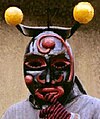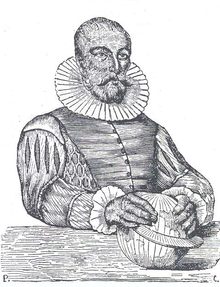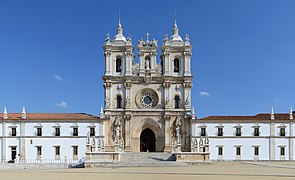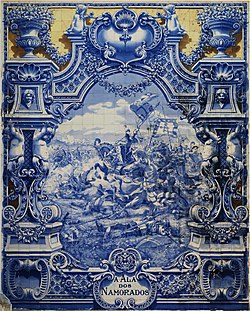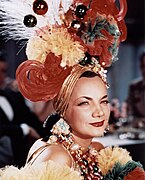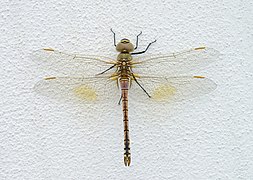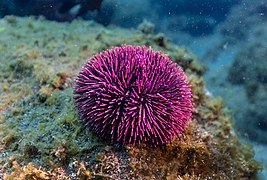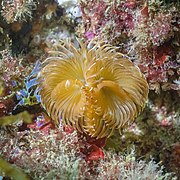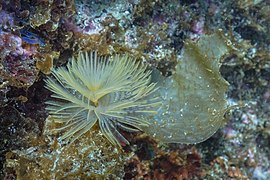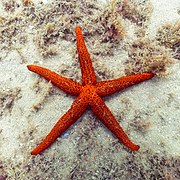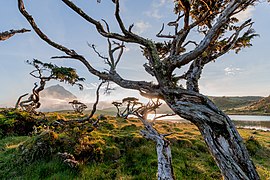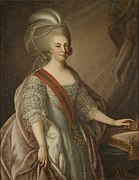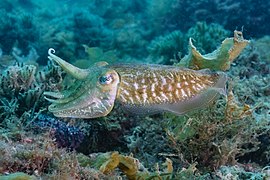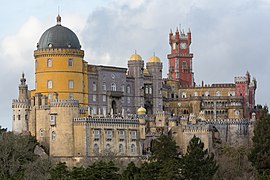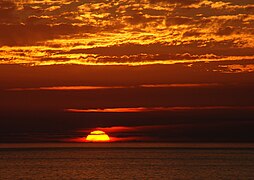Portal:Portugal
Welcome to the Portugal portal  Portugal, officially the Portuguese Republic, is a country in the Iberian Peninsula in Southwestern Europe. Featuring the westernmost point in continental Europe, Portugal borders Spain to its north and east, with which it shares the longest uninterrupted border in the European Union; to the south and the west is the North Atlantic Ocean; and to the west and southwest lie the Macaronesian archipelagos of the Azores and Madeira, which are the two autonomous regions of Portugal. Lisbon is the capital and largest city, followed by Porto, which is the only other metropolitan area. The western part of the Iberian Peninsula has been continuously inhabited since prehistoric times, with the earliest signs of settlement dating to 5500 BC. Celtic and Iberian peoples arrived in the first millennium BC. The region came under Roman control in the second century BC, followed by a succession of Germanic peoples and the Alans from the fifth to eighth centuries AD. Muslims conquered the mainland of present-day Portugal in the eighth century, and Islamic rule was expelled by the Christian Reconquista culminating with the final capture of Faro, between 1238 and 1249 AD. Modern Portugal began taking shape during this period, initially as a county of the Christian Kingdom of León in 868 and subsequently as a sovereign Kingdom with the Treaty of Zamora in 1143. As one of the earliest participants in the Age of Discovery, the Kingdom of Portugal settled Madeira and the Azores, and established itself as a major economic and political power, largely through a maritime empire that extended mostly along the South Atlantic and Indian Ocean coasts. The Portuguese were among the first Europeans to explore and discover new territories and sea routes in South America, sub-Saharan Africa, and southern and eastern Asia, establishing a global commercial network of settlements, colonies, and trading posts. Lucrative trade in spices, slaves, and various other commodities enriched the kingdom and fueled a cultural renaissance, but could not stem growing internal political challenges. A dynastic crisis in the early 1580s resulted in the Iberian Union (1580–1640), which unified Portugal under Spanish rule, marking its gradual decline as a global power. Portuguese sovereignty was regained in 1688 following a costly and protracted war, while the 1755 Lisbon earthquake destroyed the city and further damaged the empire's economy. (Full article...) Selected article -Santa Cruz is a former civil parish in the municipality of Coimbra, Portugal. In 2013, the parish merged into the new parish Coimbra (Sé Nova, Santa Cruz, Almedina e São Bartolomeu). In 2001, its population was 6866 inhabitants, in an area of 5.56 km2 that parallels the north (right) margin of the Mondego River, extending to the village of Adémia in Trouxemil (its density is approximately 1235 inhabitants per km2). (Full article...) This is a Featured article, which represents some of the best content on English Wikipedia.
Dom Pedro I (12 October 1798 – 24 September 1834) was the founder and first ruler of the Empire of Brazil, where he was known as "the Liberator". As King Dom Pedro IV, he reigned briefly over Portugal, where he also became known as "the Liberator" as well as "the Soldier King". Born in Lisbon, Pedro I was the fourth child of King Dom John VI of Portugal and Queen Carlota Joaquina, and thus a member of the House of Braganza. When the country was invaded by French troops in 1807, he and his family fled to Portugal's largest and wealthiest colony, Brazil. The outbreak of the Liberal Revolution of 1820 in Lisbon compelled Pedro I's father to return to Portugal in April 1821, leaving him to rule Brazil as regent. He had to deal with challenges from revolutionaries and insubordination by Portuguese troops, all of which he subdued. The Portuguese government's threat to revoke the political autonomy that Brazil had enjoyed since 1808 was met with widespread discontent in Brazil. Pedro I chose the Brazilian side and declared Brazil's independence from Portugal on 7 September 1822. On 12 October, he was acclaimed Brazilian emperor and by March 1824 had defeated all armies loyal to Portugal. A few months later, Pedro I crushed the short-lived Confederation of the Equator, a failed secession attempt by provincial rebels in Brazil's northeast. (Full article...) General imagesThe following are images from various Portugal-related articles on Wikipedia.
Selected quote -"Fame, for me, is that thing that allows me to multiply number of my friends"
A fama para mim é aquilo que me permite multiplicar o número de amigos. This is a Good article, an article that meets a core set of high editorial standards.
Fernão Pires de Andrade (also spelled as Fernão Peres de Andrade; in contemporary sources, Fernam (Fernã) Perez Dandrade) (d. 1552) was a Portuguese merchant, pharmacist, and diplomat who worked under the explorer and colonial administrator Afonso de Albuquerque. His encounter with Ming China in 1517—after initial contacts by Jorge Álvares and Rafael Perestrello in 1513 and 1516, respectively—marked the resumption of direct European commercial and diplomatic contact with China. (Even though there were Europeans in Medieval China, notably Marco Polo, that period of contact had been interrupted by the fall of the Yuan dynasty.) Although de Andrade's mission was initially a success that allowed a Portuguese embassy to proceed all the way to Beijing, relations were soon spoiled by culminating events that led to an extremely negative impression of the Portuguese in China. This included acts of his brother Simão that enraged the Chinese, false reports of the Portuguese being cannibals of kidnapped Chinese children and true reports of their conquest of Malacca, a loyal Ming tributary state. Normalized trade and relations between Portugal and the Ming dynasty would not resume until the late 1540s and the 1557 establishment of Portuguese rule over Macau. (Full article...) Selected Biography -Pedro Nunes (Portuguese: [ˈpeðɾu ˈnunɨʃ]; Latin: Petrus Nonius; 1502 – 11 August 1578) was a Portuguese mathematician, cosmographer, and professor, probably from a New Christian (of Jewish origin) family. Considered one of the greatest mathematicians of his time, Nunes is best known for being the first to approach navigation and cartography with mathematical tools. Among other accomplishments, he was the first to propose the idea of a loxodrome (a rhumb line), and was the inventor of several measuring devices, including the nonius (from which the Vernier scale was derived), named after his Latin surname. (Full article...) Selected picture - A view of the 25 de Abril Bridge in Lisbon
Did you know -
Portugal topicsPortugal lists
SubcategoriesRecognized content
Featured articlesFormer featured articlesFeatured listsFormer featured listsGood articles
Former good articlesDid you know? articles
Featured pictures
Former featured portalsIn the News articles
Main page featured articles
Picture of the day pictures
Featured topicsNew articlesThis list was generated from these rules. Questions and feedback are always welcome! The search is being run daily with the most recent ~14 days of results. Note: Some articles may not be relevant to this project.
Rules | Match log | Results page (for watching) | Last updated: 2025-03-15 22:20 (UTC) Note: The list display can now be customized by each user. See List display personalization for details.
Things you can doRelated PortalsRelated WikiProjects
Associated WikimediaThe following Wikimedia Foundation sister projects provide more on this subject:
Discover Wikipedia using portals
|



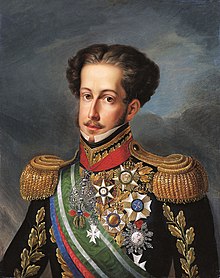















![Image 16Maios celebration in Madeira island [1] (from Culture of Portugal)](http://upload.wikimedia.org/wikipedia/commons/thumb/e/e1/2011-03-05_03-13_Madeira_045_Santana_%285543431418%29.jpg/120px-2011-03-05_03-13_Madeira_045_Santana_%285543431418%29.jpg)






